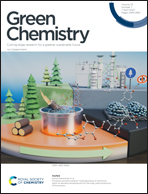Enhanced driving force and charge separation efficiency of protonated anthraquinone for C–H photooxygenation of alkanes by proton-coupled electron transfer†
Abstract
Inspired by the crucial role of the proton pump of quinone moieties in natural photosynthesis, we demonstrated a novel “donor–acceptor” strategy for boosting the aerobic visible-light photocatalytic C–H oxygenation of unactivated alkanes, through the protonation of anthraquinones by Brønsted acids. As expected, the combination of 2-ethylanthraquinones and HCl efficiently photooxidized cyclohexane to afford the corresponding alcohol and ketone products, with a high cyclohexane conversion of up to 36% and a 3.6-fold enhancement over 2-ethylanthraquinone alone. In comparison, H3PO4 or KH2PO4 as an acid source promotes the process with a higher chemoselectivity towards the ketone (>90%). This increased photooxidation power of protonated anthraquinone was used for the selective photooxygenation of other alkanes in good yields, resulting in altered product distributions. Spectroscopic evidence and photoelectrochemical studies revealed that the hydrogen bond (⋯[H+]⋯) formed between the anthraquinones and Brønsted acids established a proton coupled electron transfer (PCET) pathway for charge transfer with a longer-lived charge separation state, which modulated the reactivity of excited-state organic reactions. Control experiments and computational studies further support the importance of the thermodynamic driving force as well as geometrical reorganization, in which the formation of a hydrogen-bonded anthraquinone decreases the reorganization penalty during the energy transfer event.



 Please wait while we load your content...
Please wait while we load your content...